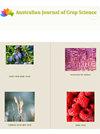Green bean biochemical attributes of Arabusta coffee hybrids from Kenya using HPLC and soxhlet extraction methods
Q3 Agricultural and Biological Sciences
引用次数: 1
Abstract
Robusta coffee yields higher than Arabica coffee. However, it is limited by the inferior cup quality. The biochemical compounds found in coffee interact and determines the final cup quality. The objective of the study was to characterize the biochemical compounds found in Arabusta coffee hybrids. Twenty coffee genotypes including the Arabusta hybrids, backcrosses, Robusta and Arabica coffee were established at KALRO-Alupe (Busia) and Siaya -ATC in the year 2015. Coffee cherry was harvested and processed in the year 2018 and the green beans were analysed for sucrose, oil, trigonelline, caffeine and chlorogenic acids using the HPLC and soxhlet method. There were significant differences amongst the genotypes for these biochemical compounds across the two different environments (Busia and Siaya counties). Robusta recorded higher levels of caffeine and chlorogenic acids while the Arabusta hybrids recorded intermediate levels of the biochemical compounds between the Robusta and Arabica coffee species. The Genotype by Environment (G x E) interaction effect was only significant for chlorogenic acids. Caffeine, sucrose, oil and trigonelline levels were significantly high for genotypes evaluated in Siaya when compared to Busia. Chlorogenic acid had a positive significant association with caffeine, but was negatively correlated with coffee oil and sucrose. Coffee oil indicated a positive significant association with sucrose and Trigonelline. The Principal Component Analysis (PCA) differentiated the genotypes based on the levels of biochemical compounds indicating high genetic variation amongst the genotypes. Arabusta hybrids exceeded Robusta coffee in performance of biochemical compounds which implies that there was a successful introgression of quality genes利用高效液相色谱法和索氏提取法研究肯尼亚阿拉巴斯塔咖啡杂交种的绿豆生化特性
罗布斯塔咖啡的产量高于阿拉比卡咖啡。然而,它受到劣质杯子质量的限制。咖啡中的生化化合物相互作用,决定了咖啡的最终品质。该研究的目的是表征在阿拉伯斯塔咖啡杂交品种中发现的生化化合物。2015年,在KALRO-Alupe (Busia)和Siaya -ATC建立了20种咖啡基因型,包括阿拉巴斯塔杂交、回交、罗布斯塔和阿拉比卡咖啡。咖啡樱桃于2018年收获并加工,使用高效液相色谱法和索氏法分析了四季豆中的蔗糖、油、葫芦巴碱、咖啡因和绿原酸。这些生化化合物的基因型在两种不同环境(Busia和Siaya县)之间存在显著差异。罗布斯塔咖啡的咖啡因和绿原酸含量较高,而阿拉巴斯塔杂交咖啡的生化化合物含量介于罗布斯塔和阿拉比卡咖啡之间。环境基因型(gx E)互作效应仅在绿原酸上显著。与Busia相比,Siaya基因型的咖啡因、蔗糖、油和葫芦巴碱水平显著较高。绿原酸与咖啡因呈显著正相关,与咖啡油和蔗糖呈显著负相关。咖啡油与蔗糖和葫芦巴碱呈显著正相关。主成分分析(PCA)基于生物化学成分的水平对基因型进行了区分,表明基因型之间存在较大的遗传变异。阿拉巴斯塔杂交种在生化指标上优于罗布斯塔咖啡,说明优质基因的渗进是成功的
本文章由计算机程序翻译,如有差异,请以英文原文为准。
求助全文
约1分钟内获得全文
求助全文
来源期刊

Australian Journal of Crop Science
农林科学-农艺学
CiteScore
1.20
自引率
0.00%
发文量
75
审稿时长
3.5 months
期刊介绍:
Information not localized
 求助内容:
求助内容: 应助结果提醒方式:
应助结果提醒方式:


